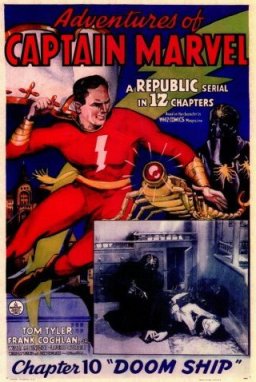
Adventures of Captain Marvel is a 1941 American 12-chapter black-and-white movie serial from Republic Pictures, produced by Hiram S. Brown, Jr., directed by John English and William Witney, that stars Tom Tyler in the title role of Captain Marvel and Frank Coghlan, Jr. as his alter ego, Billy Batson. The serial was adapted from the popular Captain Marvel comic book character, then appearing in the Fawcett Comics publications Whiz Comics and Captain Marvel Adventures. The character is now owned by DC Comics and is known as Shazam.

Zombies of the Stratosphere is a 1952 colorless Republic Studios serial directed by Fred C. Brannon, with a screenplay by Ronald Davidson, and special effects by Republic's Lydecker brothers. It was intended to be Republic's second serial featuring "new hero" Commando Cody and the third 12-chapter serial featuring the rocket-powered flying jacket and helmet introduced in King of the Rocket Men (1949). Instead, for reasons unknown, the hero was renamed "Larry Martin", who must prevent Martian invaders from using a hydrogen bomb to blow Earth out of its orbit, so that the Martians can move a dying Mars into a much closer orbital position to the Sun. As in Radar Men from the Moon, much of the screen time for each of the dozen chapters is spent on fistfights and car chases between the heroes and a gang of earthly crooks hired by renegade scientist Dr. Harding and his extraterrestrial colleague Marex to steal and stockpile the Atomic supplies needed for construction of the H-bomb.

S O S Coast Guard is a 1937 Republic film serial. It was the seventh of the sixty-six serials made by Republic. The plot concerns the mad scientist Boroff attempting to sell a superweapon to the highest bidder, opposed by Coast Guard Lieutenant Terry Kent, for both personal and professional reasons.

Drums of Fu Manchu (1940) is a 15-chapter Republic serial film based on the character created by Sax Rohmer. Though using the title of the ninth novel in the series, it actually is based on numerous elements from throughout the series to that point, cherry-picked by the writers. It starred Henry Brandon, William Royle and Robert Kellard. It was directed by the successful serial team constituee by William Witney and John English and is often considered one of the best serial films ever made.

The Fighting Devil Dogs (1938) is a 12-chapter Republic movie serial starring Lee Powell and Herman Brix, the latter better known by his later stage name, Bruce Bennett. It was directed by William Witney and John English. While not often considered a great serial, as it contains much stock footage and two recap chapters, it is famous for its main villain, the Lightning—the first costumed supervillain. There is some speculation that George Lucas used the Lightning as a template for Darth Vader.
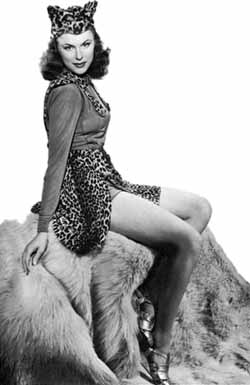
The Tiger Woman (1944) is a 12-chapter film serial by Republic Pictures starring Allan Lane and Linda Stirling. The serial was re-released in 1951 under the title Perils of the Darkest Jungle and, in 1966, it was edited into the 100-minute Century-66 film Jungle Gold.

Jungle Girl is a 1941 15-chapter Republic serial starring Frances Gifford. It was directed by William Witney and John English based on the novel Jungle Girl (1932) by Edgar Rice Burroughs. It was the 22nd of the 66 serials produced by Republic.

King of the Royal Mounted (1940) is a Republic Pictures northern serial based on the King of the Royal Mounted comic strip directed by William Witney and John English.

The Vigilantes Are Coming is a 1936 American Republic film serial directed by Ray Taylor and Mack V. Wright. It was the third of the sixty six serials made by Republic Pictures.
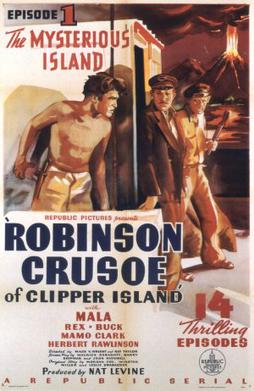
Robinson Crusoe of Clipper Island (1936) is a Republic movie serial starring Ray Mala. It was the fourth of the 66 serials produced by Republic and the last to be released in 1936. Robinson Crusoe of Clipper Island is notable for being the first Republic serial to contain another common aspect of serials—a Re-Cap Chapter, similar to a clipshow in modern television, whereby the events of the previous chapters are repeated via clips. Contrary to popular belief, this was not the invention of the concept, which had been routinely used in serial production before the release of this serial. The serial was edited into the film Robinson Crusoe of Mystery Island, which was released in 1966.
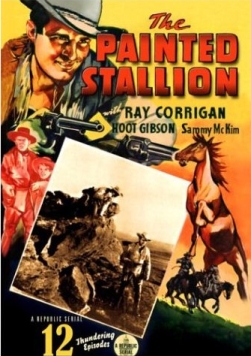
The Painted Stallion is a 1937 American Western film serial from Republic Pictures. It was the sixth Republic serial of the sixty-six made by that company. Western serials such as this made up a third of the serials from Republic, a studio that was also heavily involved in making B-Western feature films at the time.

The Lone Ranger Rides Again is a 1939 American Republic serial. It was a sequel to Republic's 1938 serial The Lone Ranger, which had been highly successful, and the thirteenth of the sixty-six serials produced by Republic.

Dick Tracy vs. Crime, Inc. (1941) is a Republic Movie serial based on the Dick Tracy comic strip. It was directed by the team of William Witney and John English with Ralph Byrd reprising his role from the earlier serials. It was the last of the four Dick Tracy serials produced by Republic, although Ralph Byrd went on to portray the character again in two features and on television.
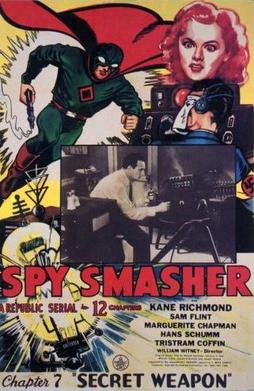
Spy Smasher is a 12-episode 1942 Republic serial film based on the Fawcett Comics character Spy Smasher which is now a part of DC Comics. It was the 25th of the 66 serials produced by Republic. The serial was directed by William Witney with Kane Richmond and Marguerite Chapman as the leads. The serial was Chapman's big break into a career in film and television. Spy Smasher is a very highly regarded serial. In 1966, a television film was made from the serial footage under the title Spy Smasher Returns.
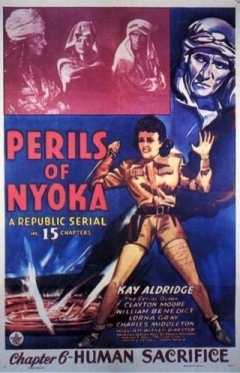
Perils of Nyoka is a 1942 Republic serial directed by William Witney. It stars Kay Aldridge as Nyoka the Jungle Girl, a character who first appeared in the Edgar Rice Burroughs-inspired serial Jungle Girl.
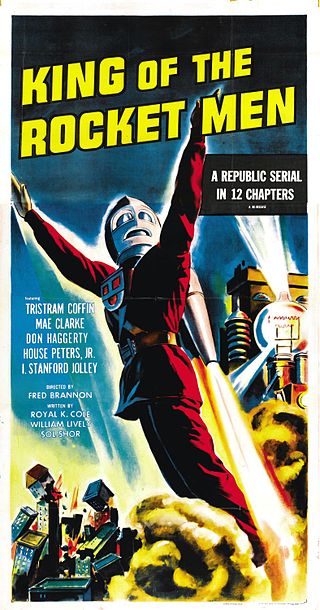
King of the Rocket Men is a 1949 12-chapter movie serial from Republic Pictures, produced by Franklin Adreon, directed Fred C. Brannon, that stars Tristram Coffin, Mae Clarke, Don Haggerty, House Peters, Jr., James Craven, and I. Stanford Jolley.

Flying Disc Man from Mars is a 1950 Republic Pictures 12-chapter black-and-white science fiction adventure film serial, produced by Franklin Adreon, directed by Fred C. Brannon, that stars Walter Reed, Lois Collier, Gregory Gaye, James Craven, Harry Lauter, and Richard Irving. Disc Man is considered a weak example of the serial medium, even compared to other post-World War II serials. In 1958 Republic edited the serial's 167 minutes of footage into a 75-minute feature, released under the new title Missile Monsters.

Captain America is a 1944 Republic black-and-white 15-chapter serial film loosely based on the Timely Comics character Captain America. It was the last Republic serial made about a superhero. It also has the distinction of being the most expensive serial that Republic ever made. It stands as the first theatrical release connected to a Marvel character; the next theatrical release featuring a Marvel hero would not occur for more than 40 years. It was the last live-action rendition of a Marvel character in any medium until Spider-Man appeared in the Spidey Super Stories segment of the children's television series The Electric Company in 1974.
Doctor Satan's Robot is a 1966 made for television film condensed from the original 1940 Mysterious Doctor Satan film serial named after its chief villain. Master criminal Doctor Satan has a nemesis, a masked mystery man, the "Copperhead", whose secret identity is Bob Wayne. Wearing a copper mask, Wayne is searching for justice and revenge on Satan for the death of his step-father. With Doctor Satan creating a mechanical robot that will terrorize the world, Wayne is determined to stop the criminal plans of the evil doctor.













